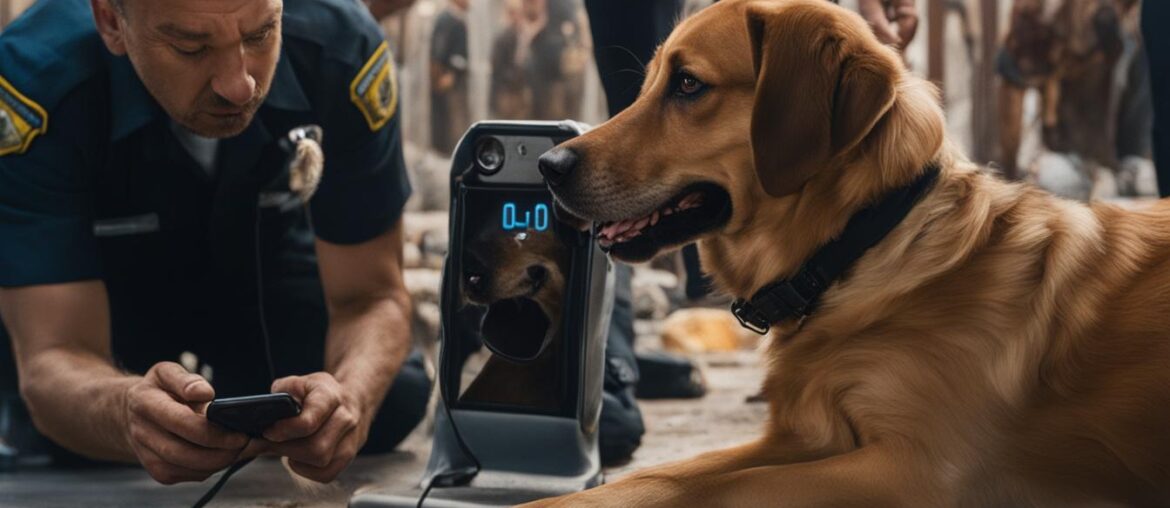Excessive drooling in dogs can be a cause for concern, especially if your dog starts drooling a lot more than usual or if they never drool but suddenly start. It is important to understand the reasons behind excessive drooling in dogs and when it could signal an emergency situation. Let’s explore the causes, symptoms, and when to seek veterinary help for excessive drooling in dogs.
Key Takeaways:
- Excessive drooling in dogs can be a sign of an underlying health issue or an emergency.
- Normal drooling is often breed-specific or occurs in specific situations, while excessive drooling is when a dog who doesn’t usually drool starts drooling excessively.
- Common causes of excessive drooling include gastrointestinal disorders, oral issues, mouth injuries, toxins, and infections.
- If your dog is exhibiting excessive drooling along with other symptoms like vomiting, diarrhea, or changes in behavior, it is recommended to seek immediate veterinary help.
- Veterinarians can diagnose the underlying cause of excessive drooling through physical examination and diagnostic tests.
Why Do Dogs Drool?

Drooling is a normal behavior for many dogs and is usually triggered by seeing food or treats. When a dog eats, their salivary glands produce saliva to aid in digestion, and drooling occurs when saliva escapes from the mouth. Certain breeds, like Mastiffs and St. Bernards, may drool more than others due to their large upper lips.
If you’ve ever seen a dog eagerly anticipate a meal or sniff out a delicious treat, you’ve probably witnessed their drooling in action. It’s a natural response that helps prepare their bodies for the intake of food.
Saliva plays an important role in the digestive process. It starts breaking down food as soon as it enters the mouth, making it easier to swallow and digest. Dogs have a considerable amount of saliva that they produce throughout the day, and sometimes, it simply overflows from their mouths.
While drooling is generally harmless, it can become excessive due to various factors. In some cases, it may be related to underlying health conditions or be a sign of distress. If your dog is drooling excessively without an apparent trigger or if their drooling habits have suddenly changed, it’s worth investigating further to ensure their well-being.
What triggers excessive drooling in dogs?
Several factors can contribute to excessive drooling in dogs:
- Pain or discomfort
- Anxiety or stress
- Dental problems
- Nausea or digestive issues
- Heat or excessive panting
- Allergic reactions
About 85% of drooling cases are related to normal drooling in response to food or environmental triggers. However, it’s crucial to be aware of any changes in your dog’s drooling habits, as excessive drooling can sometimes indicate an underlying health issue that requires medical attention.
Common Causes of Excessive Drooling
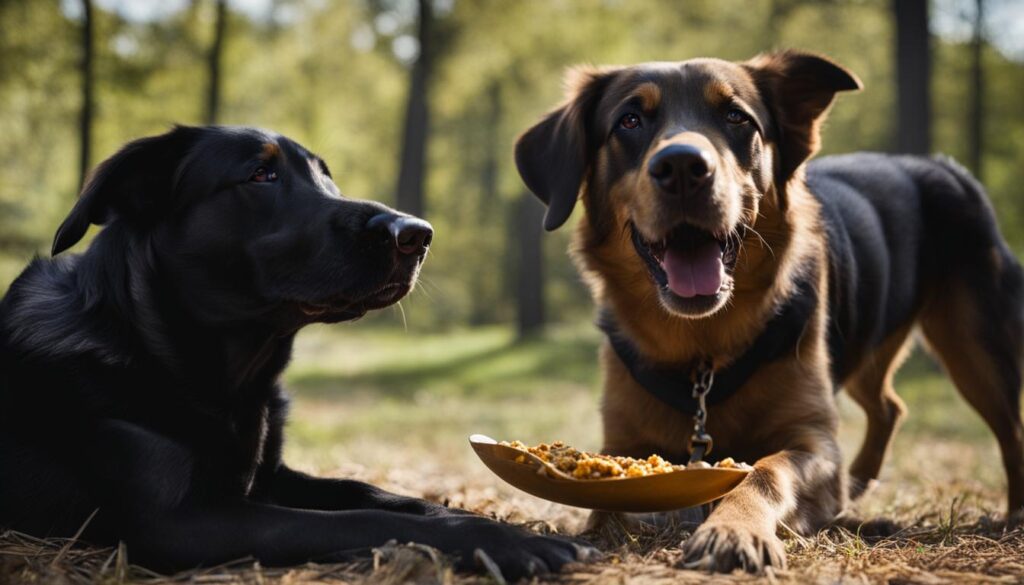
Excessive drooling in dogs, also known as hypersalivation, can indicate a serious or even life-threatening condition. Understanding the causes of excessive drooling is crucial in identifying the underlying issue and providing appropriate treatment for your furry friend.
Here are some common causes of excessive drooling in dogs:
- Gastrointestinal disorders: Digestive issues such as gastrointestinal blockages or inflammation can lead to excessive drooling.
- Gum disease or oral issues: Periodontal disease, dental infections, or mouth ulcers can cause discomfort and excessive drooling.
- Mouth injury: Trauma to the mouth, including cuts, burns, or foreign objects lodged in the oral cavity, can result in excessive drooling.
- Chemical or electrical burns: Exposure to corrosive substances or electrical shock can cause irritation and hypersalivation.
- Toxins and venoms: Ingestion of toxic plants, poisonous substances, or bites from venomous animals can trigger excessive drooling as a response to the toxins.
- Anxiety: Dogs may drool excessively due to stress or anxiety-inducing situations.
- Pain in the abdomen: Abdominal pain caused by conditions like pancreatitis or gastrointestinal obstruction can stimulate excessive drooling.
- Neurological conditions: Certain neurological disorders or brain abnormalities can disrupt the regulation of saliva production, resulting in hypersalivation.
- Viral or bacterial infection: Infections affecting the mouth, throat, or salivary glands can lead to increased drooling.
- Congenital defects: Some dogs may be born with anatomical abnormalities or malformations that affect their saliva production and swallowing, causing excessive drooling.
These conditions can cause nausea, discomfort, or damage to the salivary glands, leading to excessive drooling in dogs. Recognizing these potential causes is essential in determining the appropriate course of action to address your dog’s excessive drooling.
When to See a Vet for Excessive Drooling
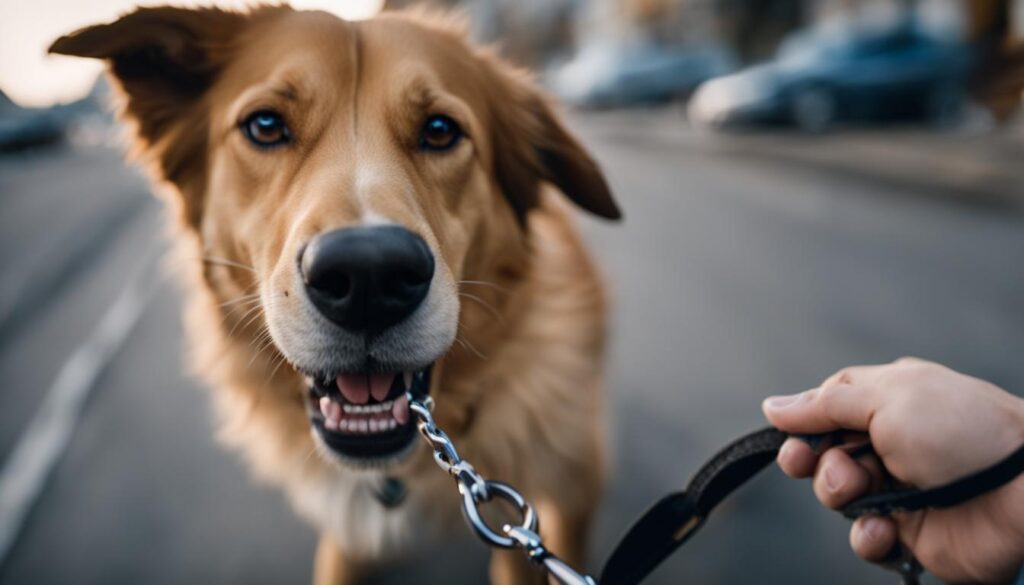
If your dog is experiencing excessive drooling along with other concerning symptoms, it is crucial to seek veterinary assistance promptly. Excessive drooling in dogs can be indicative of an underlying medical condition or even an emergency situation. There are certain signs and symptoms that should prompt you to reach out to a vet for a thorough evaluation and appropriate treatment.
Signs to Look Out For
If your dog is exhibiting any of the following symptoms along with excessive drooling, it is recommended to consult with a veterinarian:
- Vomiting
- Diarrhea
- Bleeding or blood in the saliva
- Lethargy and decreased energy
- Loss of appetite
- Changes in behavior
- Difficulty swallowing
- Restlessness and discomfort
- Abdominal distention
- Pawing at the mouth
These additional symptoms, when present alongside excessive drooling, may suggest an emergency situation that requires immediate veterinary attention.
“If your dog is exhibiting excessive drooling along with other symptoms such as vomiting, diarrhea, bleeding, lethargy, loss of appetite, changes in behavior, difficulty swallowing, restlessness, abdominal distention, or pawing at the mouth, it is recommended to seek immediate veterinary help.”
Remember that dogs cannot communicate their discomfort in the same way humans can, so it’s essential to be vigilant and attentive to any abnormal behaviors or physical signs. Trust your instincts and prioritize your pet’s well-being by consulting with a vet as soon as possible.
| When to See a Vet for Excessive Drooling | Action Required |
|---|---|
| Excessive drooling | Monitor for additional symptoms and behavior changes. Consult a veterinarian if the excessive drooling persists or worsens. |
| Excessive drooling with vomiting, diarrhea, or bleeding | Seek immediate veterinary assistance as these symptoms may indicate an emergency situation. |
| Excessive drooling with lethargy, loss of appetite, or difficulty swallowing | Consult a veterinarian promptly to assess the underlying cause and provide appropriate treatment. |
| Excessive drooling with restlessness, abdominal distention, or pawing at the mouth | Reach out to a vet for further evaluation as these symptoms may indicate a serious condition. |
How Vets Diagnose Excessive Drooling
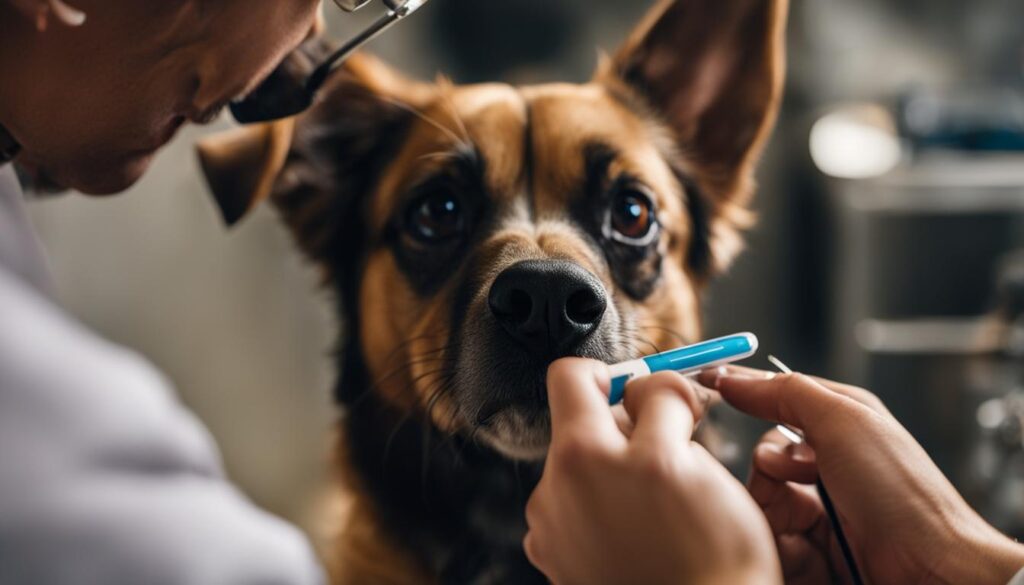
To determine the cause of excessive drooling in dogs, a veterinarian will conduct a comprehensive examination, focusing on the dog’s mouth and neck. This physical evaluation allows them to assess any abnormalities or signs of inflammation or injury.
Alongside the physical examination, the vet will also gather relevant medical information about the dog. This includes details about vaccinations, medications the dog is currently taking, exposure to potential poisons, and any recent ingestion of foreign objects. This comprehensive medical history helps the vet identify potential underlying factors contributing to the excessive drooling.
In some cases, further diagnostic tests may be necessary to pinpoint the exact cause of the excessive drooling. These tests may include:
- X-rays: Radiographs can provide a detailed view of the dog’s oral cavity, jaw, and surrounding structures, allowing the vet to identify abnormalities such as dental issues, fractured bones, or foreign objects.
- CT scans: Computed tomography scans provide more detailed imaging of the dog’s oral and cranial regions, helping identify more complex conditions or abnormalities.
- MRI: Magnetic resonance imaging can provide precise images of the dog’s soft tissues, nerves, and blood vessels, aiding in the diagnosis of conditions such as tumors or neurological disorders.
- Ultrasound: Ultrasound imaging may be used to evaluate the salivary glands, throat, and other structures in real-time, helping identify any abnormalities or signs of infection or inflammation.
- Tissue biopsy: A biopsy involves collecting a small sample of tissue for analysis, which can help identify underlying conditions such as tumors or inflammatory processes.
Based on the suspected cause of excessive drooling, the veterinarian will determine which diagnostic tests are most appropriate for each individual case. These tests enable the vet to make an accurate diagnosis and develop an effective treatment plan to address the excessive drooling and ensure the dog’s overall health and well-being.
Treatment Options for Excessive Drooling

The treatment for excessive drooling in dogs can vary depending on the underlying cause. Here are some common treatment options:
Dental Treatment
If the cause of excessive drooling is related to periodontal disease, dental treatment may be necessary. This can include tooth removal, scaling and polishing, or other dental procedures to address any oral issues.
Antibiotics
If a bacterial infection is contributing to the excessive drooling, your veterinarian may prescribe antibiotics to help clear the infection and reduce the salivation. It is important to follow the prescribed dosage and complete the full course of antibiotics.
Surgical Intervention
In cases where the excessive drooling is caused by mouth injuries or congenital defects, surgical intervention may be required. This could involve repairing any damage to the mouth or salivary glands or correcting any structural abnormalities.
Medication
To alleviate discomfort or reduce inflammation associated with excessive drooling, your vet may prescribe pain medication or anti-inflammatory drugs. These medications can help manage the symptoms and improve the overall quality of life for your dog.
Medicated Mouthwash
In some cases, your veterinarian may recommend using medicated mouthwash to help control excessive drooling and maintain oral hygiene. This can help prevent further complications and promote healing, especially if the drooling is caused by an underlying oral condition.
Surgery, Radiation, or Chemotherapy
If the excessive drooling is a result of tumors or cancerous growths in the mouth or salivary glands, your vet may recommend surgical removal of the tumor, radiation therapy, or even chemotherapy. These treatment options aim to target and eliminate cancer cells.
It’s important to consult with a veterinarian to determine the most appropriate treatment for your dog’s excessive drooling based on their specific condition. Following the recommended treatment plan can help alleviate the drooling and improve your dog’s overall health and well-being.
Normal Drooling vs. Excessive Drooling
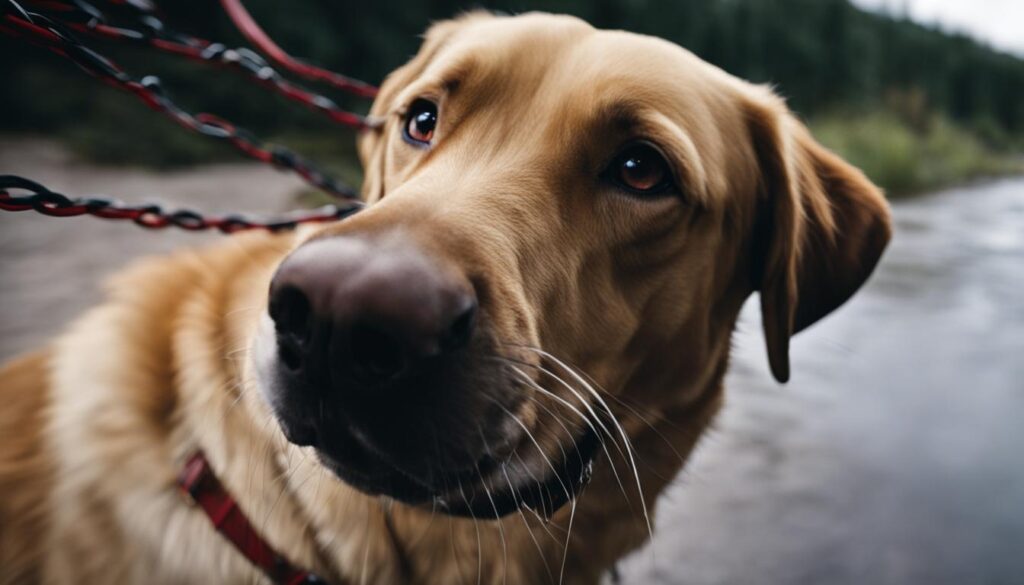
Understanding the difference between normal drooling and excessive drooling in dogs is essential for pet owners. While drooling is a natural behavior for many dogs, excessive drooling can indicate an underlying health issue or emergency. Let’s explore the characteristics of normal drooling and how it differs from excessive drooling.
Normal drooling in dogs is often breed-specific or situational. Some breeds, such as Bloodhounds or Bulldogs, naturally drool more due to their anatomy. Additionally, dogs may drool when they are excited, anticipating food, experiencing car sickness, smelling something enticing, or as a side effect of certain medications. These instances of drooling are considered normal and typically not a cause for concern.
On the other hand, excessive drooling in dogs is when a dog who doesn’t typically drool starts displaying excessive drooling or when a dog begins drooling in situations where they don’t usually drool. Excessive drooling can be a sign of an underlying health issue or emergency that requires immediate attention. It is important to monitor your dog’s drooling patterns and seek veterinary care if you notice a sudden change.
Excessive drooling may be accompanied by other symptoms such as vomiting, diarrhea, bleeding, lethargy, loss of appetite, changes in behavior, difficulty breathing, or severe pain. These additional symptoms can indicate a serious medical condition or an emergency situation that warrants prompt veterinary intervention.
Summary:
- Normal drooling is breed-specific or situational, occurring in specific contexts and not causing concern.
- Excessive drooling is when a dog who doesn’t usually drool starts drooling excessively or when a dog drools in situations they don’t typically drool.
- Excessive drooling can be a sign of an underlying health issue or emergency, especially when accompanied by other concerning symptoms.
Preventing Excessive Drooling in Dogs
While not all cases of excessive drooling can be prevented, there are some measures you can take to minimize the risk. By implementing the following strategies, you can help keep your dog’s drooling under control:
- Monitor your dog’s chewing habits to prevent objects from getting stuck in the mouth or throat.
- Keep your dog away from toxic plants or chemicals that could cause excessive drooling.
- Avoid feeding your dog table food that can lead to trauma or obstruction, resulting in excessive drooling.
- Provide regular dental care to prevent periodontal disease, which can cause excessive drooling.
By following these preventive measures, you can minimize the occurrence of excessive drooling in dogs and ensure their overall health and well-being.
| Preventive Measures | Description |
|---|---|
| Monitor chewing habits | Regularly check your dog’s chewing activities to prevent objects from causing obstruction and excessive drooling. |
| Avoid toxic plants and chemicals | Keep your dog away from plants and chemicals that can induce excessive drooling. |
| Avoid table food | Avoid feeding your dog table scraps that can lead to trauma or obstruction, resulting in excessive drooling. |
| Provide dental care | Maintain proper dental hygiene for your dog to prevent periodontal disease and minimize excessive drooling. |
When to Seek Emergency Veterinary Care for Excessive Drooling
If your dog is exhibiting excessive drooling along with symptoms such as vomiting, diarrhea, bleeding, lethargy, loss of appetite, changes in behavior, difficulty breathing, or severe pain, it is crucial to seek immediate emergency veterinary care. These symptoms could indicate a serious medical condition or an emergency situation that requires immediate attention.
In some cases, excessive drooling can be a sign of a gastrointestinal disorder, mouth injury, or even poisoning. It is important not to ignore these symptoms, as they could be an early indication of a potentially life-threatening condition.
Emergency veterinary care is necessary to properly diagnose the underlying cause of the excessive drooling and provide immediate treatment. Diagnostic tests such as X-rays, bloodwork, or a thorough physical examination may be conducted to determine the cause of the symptoms.
Remember, as a pet owner, you play a crucial role in your dog’s health and well-being. If you notice any concerning symptoms or changes in behavior, don’t hesitate to contact your veterinarian or seek emergency care. Your quick action can make all the difference in ensuring your dog receives the necessary treatment and has the best chance at a full recovery.
Wrapping Up
Excessive drooling in dogs can be a concerning symptom that should not be ignored. It can indicate a range of issues, from minor problems to more serious medical conditions. As a responsible dog owner, it is crucial to closely observe your dog’s drooling habits and seek veterinary attention if you notice any worrisome symptoms or changes in behavior.
Your veterinarian can conduct a thorough examination to determine the underlying cause of the excessive drooling and recommend the appropriate treatment. Early intervention is key when it comes to addressing potential emergencies related to excessive drooling in dogs. By taking prompt action, you can ensure the health and well-being of your furry friend.
Remember, every dog is unique, and the causes of excessive drooling can vary. It’s important to consult with a professional to get an accurate diagnosis and tailored treatment plan for your dog. By staying vigilant and prioritizing your dog’s health, you can address excessive drooling and provide the best possible care.
FAQ
Is excessive drooling in dogs an emergency?
Excessive drooling in dogs can be a cause for concern, especially if your dog starts drooling a lot more than usual or if they never drool but suddenly start. It is important to understand the reasons behind excessive drooling in dogs and when it could signal an emergency situation.
Why do dogs drool?
Drooling is a normal behavior for many dogs and is usually triggered by seeing food or treats. When a dog eats, their salivary glands produce saliva to aid in digestion, and drooling occurs when saliva escapes from the mouth.
What are the common causes of excessive drooling in dogs?
Some common causes of excessive drooling in dogs include gastrointestinal disorders, gum disease or oral issues, mouth injury, chemical or electrical burns, toxins and venoms, anxiety, pain in the abdomen, neurological conditions, viral or bacterial infection, and congenital defects.
When should I see a vet for excessive drooling in my dog?
If your dog is exhibiting excessive drooling along with other symptoms such as vomiting, diarrhea, bleeding, lethargy, loss of appetite, changes in behavior, difficulty swallowing, restlessness, abdominal distention, or pawing at the mouth, it is recommended to seek immediate veterinary help.
How do vets diagnose excessive drooling in dogs?
To determine the cause of excessive drooling in dogs, a veterinarian will perform a physical examination and check the dog’s mouth and neck. They may also take a thorough medical history, including vaccinations, medications, exposure to potential poisons, and any recent ingestion of foreign objects. Diagnostic tests such as X-rays, CT scans, MRI, ultrasound, or tissue biopsy may be recommended.
What are the treatment options for excessive drooling in dogs?
The treatment for excessive drooling in dogs depends on the underlying cause. In some cases, dental treatment, such as tooth removal, may be needed to address periodontal disease. Antibiotics may be prescribed for bacterial infections, while surgical intervention may be necessary for mouth injuries or congenital defects. Other treatment options may include pain medication, anti-inflammatory medications, medicated mouthwash, or even surgery, radiation, or chemotherapy for tumors.
How can I differentiate between normal drooling and excessive drooling in dogs?
Normal drooling is often breed-specific or occurs in certain situations like temporary excitement, car sickness, smelling something good, or as a side effect of medication. Excessive drooling, on the other hand, is when a dog who doesn’t usually drool starts drooling excessively or when a dog drools in situations they don’t typically drool. It can be a sign of an underlying health issue or emergency.
How can I prevent excessive drooling in dogs?
While not all cases of excessive drooling can be prevented, there are some measures you can take to minimize the risk. This includes monitoring your dog’s chewing habits, keeping them away from toxic plants or chemicals, avoiding table food that can cause trauma or obstruction, and providing proper dental care to prevent periodontal disease.
When should I seek emergency veterinary care for excessive drooling in my dog?
If your dog is exhibiting excessive drooling along with symptoms such as vomiting, diarrhea, bleeding, lethargy, loss of appetite, changes in behavior, difficulty breathing, or severe pain, it is crucial to seek immediate emergency veterinary care.


